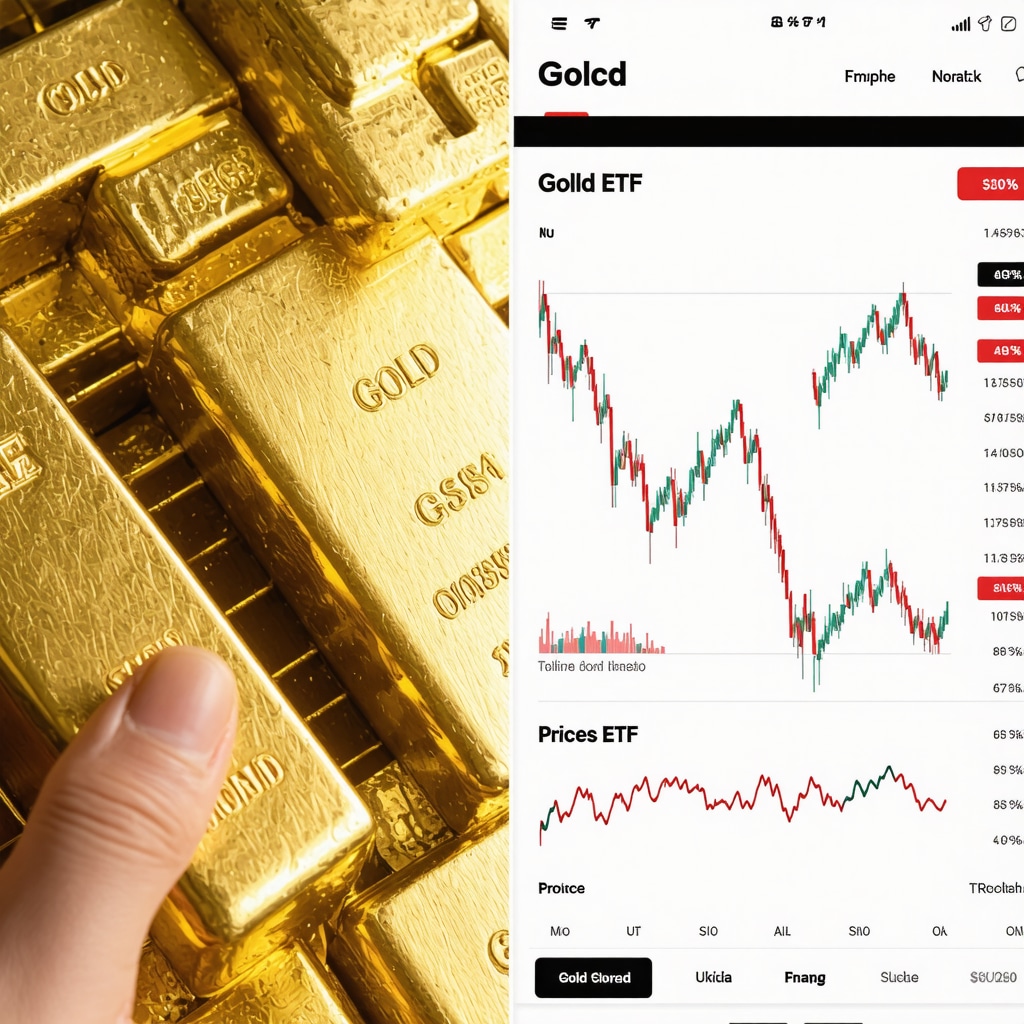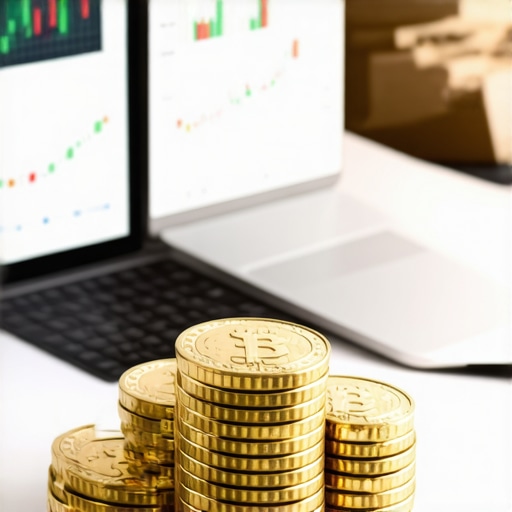How I Started Navigating Between Gold ETFs and Gold Bars
When I first dipped my toes into the world of gold investing, I was overwhelmed by the choices. Gold bars gleamed with tangible security, while gold ETFs promised the ease and flexibility of modern investing. I remember sitting at my desk, holding a small gold bar that I had just bought, and simultaneously watching the fluctuating prices of gold ETFs on my screen. That contrast made me realize that choosing between gold ETFs vs gold bars is not as straightforward as it seems.
Feeling the Weight: The Tangibility of Gold Bars
One of the reasons I was initially drawn to gold bars was their physical presence. There’s something uniquely reassuring about holding a piece of precious metal in your hands. It’s a form of wealth you can literally feel—unlike digital entries in an investment account. However, owning physical gold meant I had to think about secure storage and insurance, which added layers of complexity and cost. For those curious about safe physical gold investment, I found this guide on best practices for physical gold buying incredibly helpful.
Gold ETFs: The Modern, Liquid Alternative
On the flip side, gold ETFs offer the advantage of liquidity and ease of trading. I could buy and sell shares of gold without worrying about storage or authenticity. Yet, it also meant trusting the financial institution behind the ETF and accepting management fees that subtly eat into returns. In my experience, ETFs are ideal for those who want exposure to gold without the headaches of physical ownership. For beginners, this beginner’s guide to gold ETFs clarified many of my initial doubts.
So, Which One Should You Really Choose?
That question kept me up at night for a while. Ultimately, I realized it depends on your investment goals and comfort level. If you seek a tangible asset immune to digital risks and are prepared to handle storage, gold bars are unmatched. If you prefer convenience, liquidity, and lower entry points, gold ETFs might suit you better. It’s worth noting that the World Gold Council highlights physical gold’s role as a hedge against economic uncertainty, which resonates with my personal experience during volatile times.[1]
Learning From My Experience: Blending Both Worlds
Over time, I found a balance by diversifying between physical gold and ETFs. This hybrid approach lets me enjoy the security of physical gold while leveraging the flexibility of ETFs. For those interested, exploring options like physical gold vs ETFs can provide deeper insights into what matches your financial strategy.
If you’ve wrestled with the same choice or have insights about gold investing, I’d love to hear your story. Feel free to share your experiences or questions in the comments below.
Understanding the Hidden Costs Beyond Purchase Price
When deciding between gold ETFs and gold bars, it’s crucial to look past the sticker price and consider the ongoing costs that affect your net returns. Physical gold bars require secure storage, which might mean renting a safe deposit box or investing in a home safe with insurance. These expenses can accumulate over time, diminishing the overall profitability of your investment. Conversely, gold ETFs charge management fees, sometimes called expense ratios, which are deducted annually and can subtly erode your gains if not monitored carefully.
In my journey, I found that calculating these costs upfront helped me align my gold investments with my financial goals. For a comprehensive breakdown of costs associated with different gold investment types, see this detailed resource on comparing gold ETFs and mutual funds for optimal returns.
Risk Factors: Physical Vulnerability vs Market Exposure
Physical gold carries inherent risks such as theft, loss, or damage, which must be mitigated through insurance and secure storage. There’s also the challenge of liquidity; selling physical gold quickly at a fair price can sometimes be difficult, especially in volatile markets or if you’re dealing with large quantities.
On the other hand, gold ETFs are subject to market risks, including price volatility and potential counterparty risks if the financial institution managing the ETF faces difficulties. Understanding these risk profiles is essential for investors seeking a stable hedge against economic uncertainties. If you want to dive deeper into risk management strategies, check out the guide on effective gold investment strategies for volatile markets.
How Do Global Economic Trends Influence Your Gold Investment Choice?
Global economic shifts, such as inflation trends, geopolitical tensions, and currency fluctuations, play a decisive role in shaping gold’s price dynamics. Physical gold often outperforms during periods of extreme uncertainty because it is not tied to any financial institution or digital system. Meanwhile, gold ETFs might offer quicker reactions to market changes but can also experience sharper price swings.
For instance, during the 2008 financial crisis, physical gold demand surged as investors sought a safe harbor, while ETFs provided a more accessible but sometimes more volatile alternative. According to research by the World Gold Council, understanding these macroeconomic factors can empower investors to choose the right balance between physical gold and ETFs tailored to their risk tolerance and investment horizon.[1]
By staying informed on these trends and integrating insights from trusted sources, you can make smarter decisions that align with your long-term wealth preservation and growth strategies.
If you have experiences balancing physical gold and ETFs in your portfolio, or questions about managing these assets during economic shifts, please share your thoughts below. Engaging with fellow investors can provide valuable perspectives and enhance your investment approach.
When to Lean More Heavily on Physical Gold in Uncertain Times
Reflecting on my journey, I’ve noticed that during periods of geopolitical tension or unexpected financial crises, my instinct strongly favors physical gold. There’s a primal reassurance in tangible assets that digital holdings just can’t replicate. I recall during a recent bout of market instability, as news headlines grew darker, the weight of my gold bar felt like a silent anchor. For anyone considering bolstering their portfolio with physical gold, I found that combining insights from smart hedging strategies helped me understand when to pivot towards physical holdings.
Are There Hidden Psychological Benefits to Owning Physical Gold?
This question intrigued me deeply as I balanced my investments. Beyond the obvious financial security, there’s a psychological comfort in owning something you can hold, store, and even pass down. It’s almost ritualistic—a centuries-old tradition linking past and future generations. My personal experience taught me that this tangible connection can reduce anxiety during volatile markets. Of course, this doesn’t diminish the value of ETFs, but it adds a nuanced layer to how we perceive wealth. For those curious, exploring the best practices for safely buying physical gold also touches on this intangible aspect.
Understanding the Impact of Taxation and Regulatory Changes on Your Gold Choices
One advanced consideration that took me some time to grasp involves tax implications and evolving regulations around gold investments. Physical gold might be subject to different capital gains rules or sales taxes compared to ETFs, which can affect your net returns significantly. Tracking changes requires vigilance and sometimes professional advice. I found resources like the comparison between gold mutual funds and ETFs insightful for understanding how different vehicles respond to tax landscapes.
How Do You Balance Immediate Liquidity Needs with Long-Term Wealth Preservation?
This question kept me reflecting on my portfolio strategy. Gold ETFs offer quick liquidity, ideal for occasional portfolio rebalancing or seizing short-term opportunities. Conversely, physical gold shines as a long-term store of value, less prone to sudden market whims. In my experience, integrating both allows a dynamic approach—liquid ETFs to stay nimble, physical gold as a steadfast foundation. If you’re navigating similar dilemmas, I recommend reading about long-term gold investment strategies to complement your tactical moves.
Reflecting on the Emotional Journey of Gold Investing
Investing in gold isn’t just a financial decision; it’s deeply personal. The emotional highs and lows—watching prices soar then dip, holding a physical bar or coin versus staring at a screen—shape our relationship with wealth. I’ve learned patience and humility, recognizing that gold’s role in my portfolio is as much about peace of mind as profit. If you’ve felt this emotional rollercoaster, sharing your story can illuminate perspectives we often overlook in the data-driven world of investing.
What has your experience been balancing these different aspects of gold investment? I encourage you to share your insights or questions below. Engaging with a community genuinely enriches our understanding and helps us all become smarter investors.
Mastering the Nuances of Gold Liquidity and Timing Strategies
As my journey with gold matured, I unearthed the intricate dance between liquidity and timing that profoundly influences returns. Physical gold, while a bastion of security, demands patience and strategic foresight when entering or exiting positions. I recall moments when market volatility made quick liquidation challenging, underscoring the importance of having predetermined exit strategies and trusted buyers. Conversely, gold ETFs offer near-instant liquidity, but this convenience comes with the caveat of market hours and potential price slippage during turbulent sessions. This dynamic tension between immediacy and assurance has reshaped how I approach portfolio allocations, encouraging a thoughtful blend to harness the best of both worlds.
Integrating Advanced Portfolio Diversification With Gold Assets
Beyond simply choosing between gold bars and ETFs, I began weaving gold into a broader tapestry of asset classes to bolster resilience. Diversification is no longer just a buzzword but a tactical imperative that includes gold mining stocks, mutual funds, and even futures contracts. This multi-layered approach allows me to capture varied risk-return profiles and market exposures. For those eager to deepen their understanding, the comparison between gold ETFs and mutual funds offers a detailed analysis that complements direct physical ownership strategies.
How Do Regulatory Shifts and Tax Policies Shape Sophisticated Gold Investment Decisions?
Delving into the regulatory labyrinth revealed how crucial it is to stay informed about tax treatments and compliance nuances impacting gold investments. Physical gold often faces distinct capital gains tax rules and VAT considerations depending on jurisdiction, which can materially affect net profits upon sale. ETFs, while generally more streamlined tax-wise, are not immune to changes in securities regulations and reporting requirements. I found that consulting with tax professionals and leveraging resources like the comparison between gold mutual funds and ETFs was invaluable in navigating these complexities effectively.
Embracing the Psychological Resilience That Gold Ownership Imparts
Gold’s value transcends mere numbers; it fortifies psychological resilience during market upheavals. I’ve experienced firsthand how holding physical gold or observing ETF fluctuations can evoke contrasting emotional responses—tactile reassurance versus digital abstraction. The tangible heft of a gold bar often calms anxieties, anchoring my confidence when economic forecasts dim. This psychological buffer is supported by behavioral finance research indicating that physical asset ownership can reduce investor stress and improve long-term decision-making.[2] Integrating this insight into my strategy has made wealth preservation not only a fiscal exercise but a holistic one.
Harnessing Market Analytics and Forecasts to Refine Gold Investment Timing
To elevate my gold investment approach, I’ve increasingly relied on sophisticated market analytics and price forecast models. Tracking supply-demand dynamics, geopolitical indicators, and inflation metrics enables me to anticipate inflection points rather than merely react. For those interested in sharpening their timing strategies, the 2029 gold price forecast elucidates key drivers shaping future valuations and helps frame a proactive investment mindset.
If you’re navigating the multifaceted world of gold investments and want to exchange advanced strategies or insights, I invite you to share your experiences or questions below. Collective wisdom is a powerful catalyst for mastering these precious metal pursuits.
Things I Wish I Knew Earlier (or You Might Find Surprising)
The Real Weight of Ownership Goes Beyond Gold Bars
When I first bought physical gold, I underestimated the emotional comfort that comes with holding tangible assets. It’s not just about the metal’s value but the psychological reassurance during uncertain times. That tactile connection can really help calm investment anxieties, something I never anticipated.
Fees and Costs Are Sneaky, So Get Ahead of Them
Understanding that gold ETFs come with ongoing management fees, while gold bars require storage and insurance costs, was a game-changer for me. Early on, I overlooked these hidden expenses, and it affected my net returns more than I thought. Budgeting for these makes your strategy far more realistic.
Liquidity Isn’t Always as Simple as It Seems
Gold ETFs offer quick market access, but I learned that during times of extreme volatility, price swings can be sharp and liquidating at the right moment isn’t guaranteed. Physical gold, while slower to sell, can sometimes offer better stability if you’ve cultivated trusted buyers in advance.
Tax Implications Can Catch You Off Guard
The tax landscape around gold investments is complex. Physical gold and ETFs don’t always share the same capital gains rules or tax treatments. Early advice I received urged me to stay updated and consult professionals, which saved me from unexpected liabilities down the road.
Blending Both Worlds Creates a Stronger Portfolio
Rather than choosing one over the other, I found that a hybrid approach—combining physical gold with ETFs—balanced security with flexibility. Each serves a different purpose in my portfolio, and that diversity has been invaluable during shifting economic tides.
Resources I’ve Come to Trust Over Time
World Gold Council: Their research on gold as an investment provided me with a solid foundation, especially regarding gold’s role during economic uncertainty (source).
BuyingGoldNow.com Guides: I regularly turn to their in-depth articles like the best practices for physical gold buying and the beginner’s guide to gold ETFs. They offer approachable, trustworthy advice that helped me start smart and stay informed.
CFA Institute Behavioral Finance Research: Understanding the psychological aspects of investing through their studies added a new dimension to how I view gold ownership (read more).
Parting Thoughts from My Perspective
Choosing between gold ETFs vs gold bars isn’t just a financial decision—it’s a deeply personal journey that intertwines logic with emotion. What I’ve learned is that there’s no one-size-fits-all answer. Physical gold offers a comforting tangibility and a sense of security that digital assets can’t replicate, while ETFs provide ease, liquidity, and accessibility. The key is aligning these options with your own goals, risk tolerance, and need for flexibility.
For me, blending both has been the sweet spot—allowing me to feel grounded with physical gold while staying nimble with ETFs. If this perspective resonates or sparks questions, I’d love to hear your experiences or thoughts. Sharing stories helps all of us grow smarter and more confident in our gold investment journeys.










